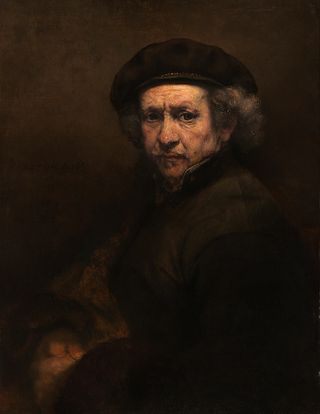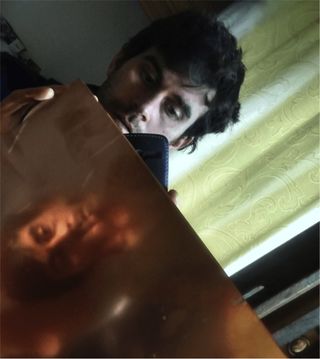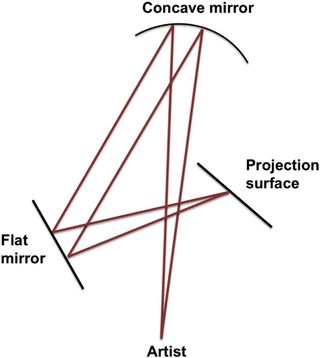Did Rembrandt Use Mirrors and Optical Tricks to Create His Paintings?

Rembrandt may have traced his celebrated self-portraits from optical projections created by assemblies of mirrors or lenses, a new analysis suggests.
Two U.K.-based researchers — Francis O'Neill, an artist and art teacher; and Sofia Palazzo Corner, an independent physicist — have identified several arrangements of a flat and curved mirror, or a flat mirror and a lens, which they say can recreate the perspectives, proportions and lighting seen in the self-portraits of the famed 17th-century Dutch painter Rembrandt Harmenszoon van Rijn.
"The evidence suggests he used lenses and projections," O'Neill and Palazzo Corner wrote in a paper published online July 13 in the Journal of Optics. "The similarity of his images to projections, in their lighting and soft focus, along with the use of lens technology by his peers and fellow artists, and the contemporary literature on the subject, all support this." [See Photos of How Rembrandt May Have Created His Self-Portraits]
O'Neill told Live Science that the new findings follow the work of British artist David Hockney and American physicist Charles Falco, who proposed in 2001 that Rembrandt and other artists had used optical instruments to capture details and proportions with almost photographic accuracy — such as the camera obscura, which projects an upside-down image into a darkened room.
"But I knew there was this hole in the theory, about self-portraits," O'Neill said, "because if they're using a camera obscura, where the subject is in the light and the artist is in the dark, how would they do self-portraits?"

In 2012, when O'Neill began painting his own self-portraits from his reflection in a flat mirror, he discovered how difficult it was to accurately paint his face while giving attention to both his reflection and his work on the canvas.
"By this stage, I'd been drawing for 20 years, and I'm teaching drawing ... but my skills did not transfer as well to the self-portrait as they did if I was drawing someone else," he said. "And I was thinking, 'How has Rembrandt done his best work in his self-portraits, if it is such a demanding physical discipline?' And so I thought, 'It has to be done this way [with optics].'"
Sign up for the Live Science daily newsletter now
Get the world’s most fascinating discoveries delivered straight to your inbox.
Through the looking glass
After discussing his ideas with other artists, O'Neill began experimenting with a pair of cosmetic mirrors bought at a pharmacy — one flat and one concave. He arranged them to project his reflection onto a metal surface so that the projected image would be as bright as possible.
At first, O'Neill used aluminum foil as the projection surface. "It wasn't the best surface, but you could achieve projections," he said. "And then I got myself some copper etching plate, and from there, I was able to make bigger and better projections — and that convinced me that this was how it was done."
The research paper by O'Neill and Palazzo Corner details several combinations of subjects, mirrors and a projection surface that result in projected images that almost exactly match the physical measurements taken from a sample of Rembrandt's self-portraits.

The researchers also analyzed other features of Rembrandt's self-portraits that they think indicate he was using projections to guide his initial drawings and final paintings, including the off-center eye line — an effect that O'Neill said was impossible to achieve accurately without using a flat mirror with a concave mirror or a refracting lens. [Gallery: Hidden Gems in Renaissance Art]
Even Rembrandt's famed use of contrasting light and dark regions, which art historians call "chiaroscuro," appears to be an artifact of the "soft focus" at the edges of a projected image. This results in very little detail where there is very little light, and a lot of detail in areas that are strongly lit, O'Neill said.
Secrets of the Old Masters
O'Neill said some art historians criticized his research; no historical record exists of Rembrandt ever using mirrors or other types of optics to help him create his paintings, they argued. But O'Neill pointed out that leading artists of the time were often secretive about their techniques, and said the historical evidence for his theory can be found by examining the paintings.
Meanwhile, work by Hockney, Falco and other researchers has demonstrated that knowledge of optical techniques, such as the use of curved mirrors and camera obscuras, was known to artists in Europe from as early as the 1350s, O'Neill said.
The new research supports the ideas proposed by Hockney and Falco that the development of optical instruments and techniques in Europe after the 14th century had a profound impact on Western art, as they did on scientific thought, O'Neill said.
"This becomes really obvious having studied it, that the invention of the lens gives mankind the possibility of seeing their position in the world," he said. "So they see the stars, and astronomy begins in earnest; they start to look through microscopes, so they're seeing the minutiae of the world. They're seeing the enormity of space, and they're seeing their own position in the world, because they are using lenses to look at themselves."
Original article on Live Science.
Tom Metcalfe is a freelance journalist and regular Live Science contributor who is based in London in the United Kingdom. Tom writes mainly about science, space, archaeology, the Earth and the oceans. He has also written for the BBC, NBC News, National Geographic, Scientific American, Air & Space, and many others.

